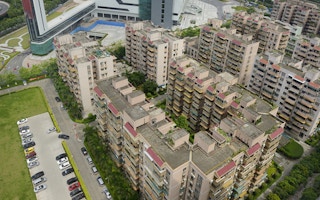China’s ambitious plan to lower pollution by adopting five million electric cars is running into a problem — a lack of charging stations.
Eddy Wu, a Shanghai resident, bought a plug-in hybrid because the car was eco-friendly, subsidised by the government and exempt from license-plate fees. Now he runs it mostly on gasoline, the electric capabilities largely wasted.
His apartment complex and office won’t let him charge the BYD Co vehicle in their parking lots, saying it poses a fire risk. Using the nearest public charging station means driving 5 kilometers (3 miles) and paying cash. With gas prices expected to tumble with the almost 40 per cent plunge in crude-oil since June, there will even less incentive to charge his Qin sedan.
“I was optimistic about charging facilities at first, but it’s been difficult,” said the 33-year-old securities analyst. “I have no choice but to use gas.”
While a dearth of charging stations is holding back adoption of electric vehicles worldwide, the problem is particularly acute in China because the country has pledged to slash greenhouse emissions and cut a reliance on imported oil, while keeping domestic carmakers competitive amid an industry shift away from conventional gasoline-powered vehicles.
“
When plug-in hybrid owners decide whether to use electricity or gasoline, the determining factor is charging facilities
Dong Yang, secretary-general of the China Association of Automobile Manufacturers
“China needs to succeed in this,” said Klaus Paur, head of the automotive department at market-research company Ipsos. “There’s dependency on oil, with almost 25 per cent of the world’s production going to China. I believe it’s the only chance for the Chinese car manufacturers to quickly catch up with international car manufacturers.”
‘Range anxiety’
In the US and Germany, “range anxiety” — or a driver’s fear of running out of power before reaching the nearest charging station — has been an obstacle to electric-car adoption. The lack of unified payment systems is another challenge, with different charging networks using incompatible electronic payment cards.
In China, many car owners, like Wu, don’t have their own garages or parking spaces at home where they can charge their plug-ins overnight.
Yan Xuefei, also a Shanghai resident, wound up striking a deal that lets him charge his Qin at night at a factory near his apartment. The 27-year-old engineer can’t charge the car at his apartment complex because the limited designated parking spots are all taken. Building managers at his office also won’t let him do it there, he said.
Still, the factory’s parking lot is uncovered, and its managers forbid him from charging the car when it rains, saying they fear safety issues like short circuits.
“The government has given generous subsidies for us to buy the cars and publicised the merits of new-energy vehicles,” Yan said. “But so many car owners can’t easily charge their cars as they don’t have designated parking spots.”
Slow demand
Demand for alternative-energy vehicles in China has been slow despite government subsidies that can reduce the cost of the cars by about 60,000 yuan ($9,750). As of September, the nation had achieved only 12 per cent of its target for alternative-energy vehicles to be introduced by 2015, according to government figures released last month. By 2020, the goal is to have 5 million of these autos on China’s roads.
The vehicles also qualify for an exemption from a 10 per cent purchase tax, as well as free license plates issued in cities including Shanghai, where plates for a conventional gasoline-powered auto can cost about $12,000.
Cutting emissions
The EU in October said it’ll cut emissions by 40 per cent in the four decades through 2030. Chinese President Xi Jinping pledged in November that his country’s emissions will peak around 2030, as it boosts its use of renewable and nuclear energy. His announcement was made jointly with a pledge by US President Barack Obama to slash emissions by 26 per cent to 28 per cent in the 20 years through 2025.
Dong Yang, secretary-general of the China Association of Automobile Manufacturers, urged the city of Beijing to speed up construction of charging stations in a blog post on Nov 24.
“When plug-in hybrid owners decide whether to use electricity or gasoline, the determining factor is charging facilities,” Dong wrote. “With the increase of charging facilities, the effects of reduced gas emissions from plug-in hybrid vehicles will become more apparent.”
The government said Nov. 25 it will give city governments incentives to speed up construction of vehicle-charging facilities. It also plans to encourage private investment in building charging stations, the Industry and Information Technology ministry said on Sept. 25.
Government incentives
The central government is considering spending as much as 100 billion yuan to build charging facilities and spur demand for new-energy vehicles, two people familiar with the matter said in August.
In Shanghai, the city’s government plans to build 6,000 charging points by 2015, while it has a target of 13,000 alternative-energy vehicles on its roads during the same time frame. It’s also working with companies including Bayerische Motoren Werke AG to build charging facilities.
Tesla, the US electric-car maker that started selling its Model S in China in April, has begun its own efforts to make charging easier for customers. The company has deals to build 400 charging points in 120 cities using the outlets of China Unicom, the nation’s second-largest mobile phone company.
Tesla also has agreements with real-estate developers Soho China Ltd and China Yantai Holdings Co to set up charging points at their properties nationwide.
When hybrid owners like Wu don’t plug in their cars, their vehicles actually wind up using more gasoline than conventional cars, according to Hubertus Troska, Daimler’s chief executive officer for the greater China region.
“You’re carrying 150 kilos of electric components with you that add to the fuel consumption,” Troska told reporters in the city of Guangzhou last month. “The effective reduction of emissions will only come if customers actually charge their plug-ins every day.”










